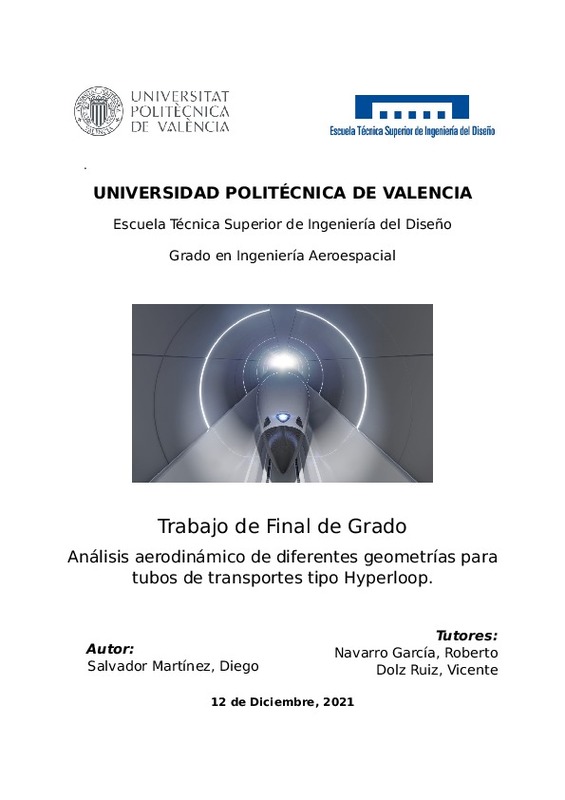JavaScript is disabled for your browser. Some features of this site may not work without it.
Buscar en RiuNet
Listar
Mi cuenta
Estadísticas
Ayuda RiuNet
Admin. UPV
Análisis aerodinámico de diferentes geometrías para tubos de transportes tipo Hyperloop
Mostrar el registro sencillo del ítem
Ficheros en el ítem
| dc.contributor.advisor | Navarro García, Roberto
|
es_ES |
| dc.contributor.advisor | Dolz Ruiz, Vicente
|
es_ES |
| dc.contributor.author | Salvador Martínez, Diego
|
es_ES |
| dc.date.accessioned | 2022-01-07T13:27:05Z | |
| dc.date.available | 2022-01-07T13:27:05Z | |
| dc.date.created | 2021-12-22 | |
| dc.date.issued | 2022-01-07 | es_ES |
| dc.identifier.uri | http://hdl.handle.net/10251/179375 | |
| dc.description.abstract | [ES] El sector del transporte está constantemente tratando de desarrollar tecnologías con el objetivo de reducir los tiempos de viaje, viajando cada vez más rápido pero asegurando a los pasajeros seguridad. En este contexto nace el concepto de Hyperloop, un nuevo tipo de transporte que se detallará posteriormente pero que consiste en un vehículo (pod) circulando por el interior de un conducto con un vacío parcial. En este trabajo se analizarán tres diferentes formas de tubos (circular, cuadrada y hexagonal) para transportes de vehículos de tipo Hyperloop con el objetivo de identificar las principales diferencias y ventajas de cada uno. Dado que es una tecnología en desarrollo, la dificultad y el coste de realizar pruebas experimentales implica que el estudio se debe realizar mediante el uso de software CFD para simular la aerodinámica del pod cuando atraviesa los tres diferentes tubos objetivo de análisis. En primer lugar, para familiarizarse con este nuevo modelo de transporte de alta velocidad, se describirá brevemente el concepto de Hyperloop. A continuación, se presentará la herramienta con la que se ha realizado el análisis principal de este trabajo, el software CFD (Computational Fluid Dynamics), que se trata de un programa para simular la mecánica de fluidos sin necesidad de realizar pruebas experimentales. En concreto el programa que se ha utilizado es Siemens StarCCM+. Una vez introducido el tema sobre el que se va a trabajar, se procederá a explicar paso por paso todo el trabajo realizado con el software StarCCM+ para finalmente mostrar los resultados obtenidos. Tras analizarlos se extraerán conclusiones acerca de las diferencias principales entre las diferentes formas de los tubos para transportes tipo Hyperloop | es_ES |
| dc.description.abstract | [EN] The transport sector is constantly trying to develop technologies with the aim of reducing travel times, travelling faster and faster but ensuring passenger safety. In this context, the Hyperloop concept was born, a new type of transport that will be detailed later but which consists of a vehicle (pod) circulating inside a conduit with a partial vacuum. This paper will analyse three different shapes of tubes (circular, square and hexagonal) for Hyperloop type of vehicle transport in order to identify the main differences and advantages of each one. As this is a developing technology, the difficulty and cost of experimental testing means that the study must be carried out using CFD software to simulate the aerodynamics of the pod as it passes through the three different tubes targeted for analysis. First, in order to become familiar with this new high-speed transport model, the Hyperloop concept will be briefly described. Then, the tool with which the main analysis of this work has been carried out will be presented, the CFD (Computational Fluid Dynamics) software, which is a programme for simulating fluid mechanics without the need to carry out experimental tests. Specifically, the program used is Siemens StarCCM+. Once the subject to be worked on has been introduced, the work carried out with the StarCCM+ software will be explained step by step and finally the results obtained will be shown. After analysing them, conclusions will be drawn about the main differences between the different shapes of the tubes for Hyperloop type transport | es_ES |
| dc.format.extent | 67 | es_ES |
| dc.language | Español | es_ES |
| dc.publisher | Universitat Politècnica de València | es_ES |
| dc.rights | Reserva de todos los derechos | es_ES |
| dc.subject | Hyperloop | es_ES |
| dc.subject | Aerodinámica | es_ES |
| dc.subject | Resistencia aerodinámica | es_ES |
| dc.subject | CFD | es_ES |
| dc.subject | Tubos | es_ES |
| dc.subject | Geometrías | es_ES |
| dc.subject | Aerodynamics | es_ES |
| dc.subject | Drag | es_ES |
| dc.subject | Tubes | es_ES |
| dc.subject | Geometries | es_ES |
| dc.subject.classification | MAQUINAS Y MOTORES TERMICOS | es_ES |
| dc.subject.other | Grado en Ingeniería Aeroespacial-Grau en Enginyeria Aeroespacial | es_ES |
| dc.title | Análisis aerodinámico de diferentes geometrías para tubos de transportes tipo Hyperloop | es_ES |
| dc.type | Proyecto/Trabajo fin de carrera/grado | es_ES |
| dc.rights.accessRights | Abierto | es_ES |
| dc.contributor.affiliation | Universitat Politècnica de València. Departamento de Máquinas y Motores Térmicos - Departament de Màquines i Motors Tèrmics | es_ES |
| dc.contributor.affiliation | Universitat Politècnica de València. Escuela Técnica Superior de Ingeniería del Diseño - Escola Tècnica Superior d'Enginyeria del Disseny | es_ES |
| dc.description.bibliographicCitation | Salvador Martínez, D. (2021). Análisis aerodinámico de diferentes geometrías para tubos de transportes tipo Hyperloop. Universitat Politècnica de València. http://hdl.handle.net/10251/179375 | es_ES |
| dc.description.accrualMethod | TFGM | es_ES |
| dc.relation.pasarela | TFGM\146130 | es_ES |
Este ítem aparece en la(s) siguiente(s) colección(ones)
-
ETSID - Trabajos académicos [8709]
Escuela Técnica Superior de Ingeniería del Diseño






